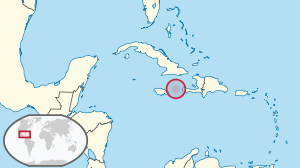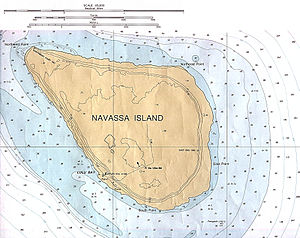Navassa
| Navassa | |
|---|---|
| Aerial view of the east coast of Navassa | |
| Waters | Jamaica Channel , Caribbean Sea |
| Archipelago | Greater Antilles |
| Geographical location | |
| surface | 5.4 km² |
| Highest elevation | Dunning Hill 77 m |
| Residents | uninhabited |
| main place | Lulu Town (historic) |
| Map of Navassa | |
Navassa ( English Navassa Island , French Île de la Navasse or La Navase , Creole: Lanavaz or Lavsh ) is an uninhabited island in the Caribbean Sea . It is located in the Jamaica Channel on about 1/4 of the route from Haiti to Jamaica and is claimed by the United States of America as a United States Minor Outlying Island . The island is also claimed by Haiti, on whose island pedestal ( Hispaniola ) it lies.
geography
Navassa is 54 km west of the Tiburon Peninsula of Haiti, 135 km northeast of Jamaica and about 160 km south of Guantánamo Bay in Cuba . Similar to the island of Henderson in the Pacific, Navassa represents a so-called " elevated atoll " and reaches a height of up to 77 meters above sea level. The island, surrounded by a coral reef, has an area of 5.4 km² and a coastline of 9 km.
The island is not permanently habitable as there are no natural freshwater sources. In addition, numerous native plants are poisonous and the ground is sometimes so sharp-edged that it cuts through footwear. The only vegetation consists of groups of trees, isolated cacti and grass on which goats graze. The island has been a nature reserve since 1999, and entry is strictly prohibited.
The location of the island, a good 160 km south of the Guantanamo Bay military base , is strategically interesting for the USA .
history
As early as 1504, Spanish and Indian sailors who rowed from Jamaica to Hispaniola during the fourth voyage of Christopher Columbus under the command of Diego Méndez to get help for the crew in distress, stranded on the island with their canoes and named them Navaza ( from Spanish nava = level). Originally assigned to Haiti, it was annexed by the United States in 1857 under the Guano Islands Act , making it the country's oldest overseas territory. However, there was no guano on the island, the white phosphorite had been mistaken for the bird droppings. After phosphorite was also used as a fertilizer, it was used, with mining intensified after the end of the Civil War in 1865. In the meantime, two Haitian warships reached the island in 1858 and declared that they would take possession of it for Haiti; the operations manager was asked to obtain Haitian approval. The instruction was not enforced. As a result, a US warship drove to the capital of Haiti, Port-au-Prince , because the two states had no diplomatic relations, and issued a note that the US insisted on its claim to the island and a warship to secure it the waters would hold up. The mining ended in 1898 during the Spanish-American War , when the island was evacuated by order of US President William McKinley . The mining company later went bankrupt. Approximately one million tons of phosphorite were extracted during the mining period. From 1903 the island was administered by the US Navy as a branch of the Guantanamo Bay Naval Base .
In 1917 Navassa was taken over by the United States Coast Guard and a lighthouse was built in the south of the island, as significantly more ships have passed the island since the opening of the Panama Canal . In 1929 the lighthouse was switched to automatic operation and the island was usually uninhabited again. Haiti let its nationals use the island again and again and built a chapel on it in 1950 so that seafarers from passing ships could pray there. In 1989, the presidential helicopter in Haiti flew to the island and briefly dropped six radio amateurs who set up international radio links with a Haitian call sign. In 1996 the lighthouse was abandoned due to advances in navigation technology and the island and the surrounding sea area fell to the Office of Insular Affairs of the United States Department of the Interior . A private citizen named William A. Warren then made claims to the island, which were rejected in 2000.
Based on the results of two research expeditions in 1998 and 1999, the island, including the waters within a 12-mile radius, was placed under nature protection on December 3, 1999 and has since been a National Wildlife Refuge by the United States Fish and Wildlife Service under the name Navassa National Wildlife Refuge managed. During several expeditions since the 19th century, various new species have been discovered on the island, including the last specimen of the Pseudophoenix sargentii saonae (subspecies: navassana ), a prehistoric palm , as well as several endemic reptile species , some of which are now extinct be valid.
Claims to the island
State claims
The United States claim stems from the Guano Islands Act and took effect in 1857. The Supreme Court of the United States ruled in Jones v. United States that the Guano Islands Act is constitutional and that the island is part of US territory.
In contrast, Haiti declared a comprehensive claim to the surrounding islands in its first constitution of 1801, but only listed the larger islands by name. The neighboring islands have not been named since 1806. Only after the USA had registered its claim, since the constitution of 1874 and until today, has Haiti explicitly named the island as La Navase in the constitutional text as part of Haiti.
Warren v. United States
In 1996, after a visit to the island, a US documentary filmmaker filed a new claim under the Guano Islands Act, claiming that the island was now uninhabited and that the Coast Guard had given up US state ownership of the lighthouse. The case was ruled by the United States Court of Appeals for Washington, DC in 2000 , confirming the 1857 claims of the United States and dismissing the 1996 claims.
The island is now also claimed by the Italian and former Honorary Consul of Somalia , Ezio Scaglione . After an illegal landing on the island there on October 12, 2005, he proclaimed the internationally unrecognized micronation of the Principality of Navassa ( Principado de Navaza ), as its prince - possibly in the hope of avoiding prosecution as a head of state with diplomatic immunity . Scaglione is accused of having used his office as honorary consul to dump toxic waste off the Somali coast in collaboration with some northern Italian industrialists and former Somali President Ali Mahdi Muhammad and to have engaged in the arms trade between Iraq, Ireland, Lebanon and Somalia. The film Toxic Somalia (broadcast by Arte ) deals in part with this case.
See also
literature
- Hernando Colón : Historia del Almirante . Capítulo CV (Spanish, available online through artehistoria.com - Describing the journey of Diego Méndez from Jamaica to Hispaniola).
- Fabio Spadi: Navassa: Legal Nightmares in a Biological Heaven? In: Boundary & Security Bulletin . tape 9 , no. 3 . International Boundaries Research Unit, Department of Geography, University of Durham , 2001, ISSN 0967-411X , p. 115–130 (English, online - legal essay on the Navassa dispute between the United States and Haiti).
Web links
- Navassa National Wildlife Refuge. United States Fish and Wildlife Service (English).
- CIA World Factbook: Navassa Island (English).
- Navassa Island: A Photographic Tour (1998–1999). United States Geological Survey (USGS), website with numerous photos of Navassa.
- Principado de Navaza. Website of the “Principality of Navassa” (Spanish).
Individual evidence
- ↑ Navassa ( memento of September 25, 2010 in the Internet Archive ) in the island encyclopedia oceandots.com (English), accessed on May 8, 2017
- ↑ Navassa National Wildlife Refuges fact sheet. (PDF; 344 kB) In: Navassa National Wildlife Refuge. United States Fish and Wildlife Service , accessed May 11, 2017 .
- ↑ World Atlas and Country Lexicon, Tandem-Verlag GmbH.
- ↑ a b Fabio Spadi: Navassa: Legal Nightmares in a Biological Heaven? In: Boundary & Security Bulletin . tape 9 , no. 3 . International Boundaries Research Unit, Department of Geography, University of Durham , 2001, ISSN 0967-411X , p. 115–130 (English, online - legal essay on the Navassa dispute between the United States and Haiti).
- ↑ Explore Navassa - History. In: Navassa Island: A Photographic Tour (1998–1999). United States Geological Survey (USGS), accessed May 11, 2017 .
- ^ US Unincorporated Possessions. Navassa Island. In: World Statesmen.org. Retrieved May 11, 2017 .
- ^ "Galapagos of the Caribbean" - The Expedition. In: Navassa Island: A Photographic Tour (1998–1999). United States Geological Survey (USGS), accessed May 11, 2017 .
- ^ Island Lists of West Indian Amphibians and Reptiles . In: Robert Powell, Robert W. Henderson (Eds.): Bulletin of the Florida Museum of Natural History . tape 51 , no. 2 . University of Florida, Gainesville, May 25, 2012, ISSN 0071-6154 , Hispaniola and Navassa, S. 129 (English, online [PDF; 2.3 MB ]).
- ↑ Supreme Court: Jones v. United States - 137 US 202 (1890) , ruled November 24, 1890.
- ^ Organization of American States: Constitution de la Republique Haiti , Art. 8.
- ↑ United States Court of Appeals for the District of Columbia Circuit: Warren v. United States - 00-5130 (2000) , ruled December 26, 2000.
- ↑ Confirmación de soberanía e independencia. Declaration of independence of the "Principality of Navassa". Retrieved May 11, 2017 (Spanish).
- ↑ The poisonous ships: a dossier from Greenpeace.
- ^ Paul Moreira: Toxic Somalia, the Other Piracy. Documentary (introduction and abstract only). In: pltv.fr. Premières Lignes Télévision, May 24, 2011, accessed on May 9, 2020 .




